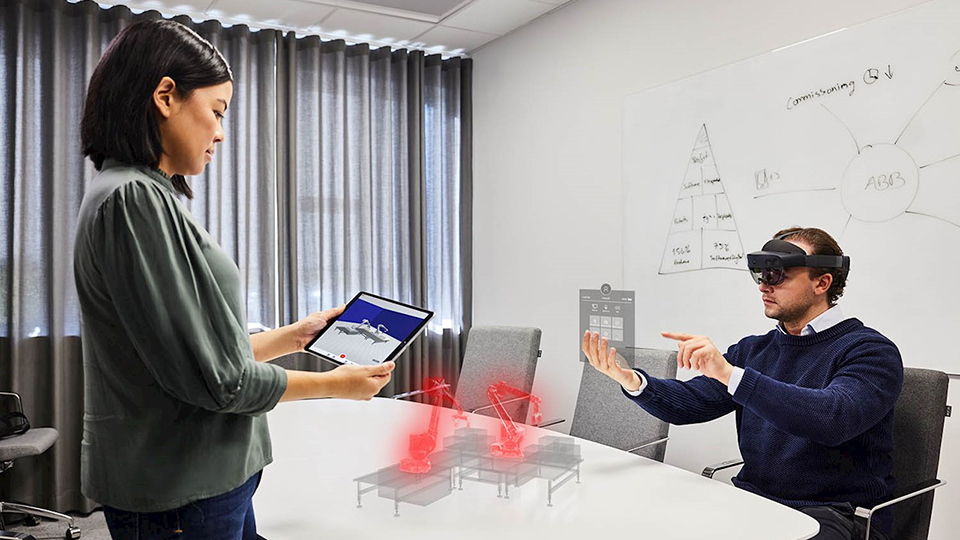With its flexibility, quality and versatility, robotic automation is growing worldwide as companies look to tackle multiple issues, from the ongoing impact of COVID-19 through to supply chain issues, rising energy prices, tightening requirements around sustainability and the changing expectations of both their workforce and their customers.
These challenges have seen many industrial robot users rethinking the way they use robotic automation to make their operations more resilient by becoming more adaptable to unexpected changes.
Previously, robots on production lines would typically be set up to perform specific activities repeatedly, but increasingly robots are required to rapidly learn to perform new jobs.
This can be achieved by techniques where the new task and movements are simulated and developed offline and then downloaded to the robot. With graphic views of what the robot will do in response to various commands, this is a quick and efficient way to teach robots new tasks without interrupting production.
This approach also helps overcome the skills shortage that is holding many companies back from using robots. In an ABB survey of 1,650 industrial companies carried out in 2020, 31 percent of respondents who had not invested in robotic automation cited lack of technical knowledge or a belief that they are too difficult to use as a key justification for not using robots.
Accurate simulation essential
Computer-based programming is well known as a way of maximizing return on investment for robotic systems, giving companies lower costs, faster time to market, and superior end products. An essential component of these solutions are virtual robot controllers, or virtual controllers (VC) for short. These offer a digital replica of the controller software that real-world physical robots use to execute programs.
The most important aspect is accuracy. With an accurate simulation, process designers can test, evaluate, and program automated processes confidently. For example, achieving an exact match between the real and simulated cycle times is critical to ensure the robot behaves as expected and to avoid bottlenecks. Predictable behaviour is also vital to ensure humans and robots can work together in smaller production cells, an increasing trend that ensures that companies get the best out of both people and machines and make best use of their available production space.
Levels of sophistication
The accuracy and usability of any robot programming and simulation tool depends on how it narrows the gap between simulation and reality.
Simulation tools can be categorised into five levels that assess how well they do this.
- Level 1: Captures typical motion of the robot system
- Level 2: Captures all possible movements of the robot system
- Level 3: Ensures the simulated movement is logically consistent with the controller software
- Level 4: Accurately captures the timing of all movements, allowing the simulation of systems involving multiple robots
- Level 5: Runs the simulation in the Cloud, allowing developers in numerous locations to cooperate on developing the application
Although all levels can provide some degree of utility, only solutions of level 3 and above offer a highly accurate virtual robot controller that can produce the gains in efficiency, flexibility, sustainability, and overall resilience that companies need.
From virtual studio to real shop floor
Just such a tool is ABB's simulation and offline programming software, RobotStudio. Allowing robot programming to be carried out on a computer in the office, RobotStudio allows engineers to conduct tasks such as training, programming and optimization without needing to shut down production.
The tool is built on the ABB Virtual Controller, an exact copy of the real software that robots use in production. The result is highly realistic simulations, using robot programs and configuration files that are identical to those used on the shop floor.
With the addition of a cloud-based version, RobotStudio offers new possibilities for collaboration between engineers, developers and systems integrators, enabling them to work together in real-time on robot cell designs from anywhere in the world, on any device. A version control feature enables users to keep track of changes and have full transparency of any amendments. With complete knowledge of who edited the program and when, developers can cut the time needed to resolve errors and performance issues.
The software’s simplified interface also enables users with little engineering expertise to program robot applications rapidly and with minimum effort.
The benefits of such a highly accurate simulation tool are helping transform automation. Plant operators can quickly reprogram deployed robots using the simulation to repurpose facilities for new products, while cutting start up and commissioning time ensures lost production is kept to a minimum.
Simulation also avoids the need for costly physical prototypes to conduct tests on, while also ensuring that the installation has the required level of safety to allow it to work with or around people. The production process can also be fine-tuned to ensure the cell is using minimum energy and materials, while accurate timing makes it possible to simulate complex production systems with many people and robots.
Reaping the rewards
Several companies are enjoying the benefits of RobotStudio. For example, IMA Schelling Group designs and commissions woodworking solutions for clients in the furniture industry.
Using ABB’s RobotStudio, the company can conduct virtual commissioning, saving around 10 to 20 percent of the time needed for a standard application and up to 50 percent for non-standard applications. With virtual methods, the company has no need to wait for the robot to be installed, dramatically cutting the normal commissioning duration of one to two months.
With people increasingly adept at using smartphone applications, graphical simulations of robot movements and behavior are a good basis for teaching students about robot programming. For example, in China, the Guangzhou Light Industry Vocational School introduced its first ABB industrial robot in 2012 and now has a total of 29. It uses Robot Studio to help students learn the skills needed to code instructions and accurately simulate and calculate robot movements in an offline environment.
Now available on a smart phone through ABB’s RobotStudio® Augmented Reality Viewer app, the program allows staff to see what a robotic cell design will look like in situ on the production floor, in the palm of their hand. The smartphone app uses Augmented Reality (AR) technology to overlay model designs created in RobotStudio into a real-life production environment, with imagery that users can access through their phone or other smart device. This allows users to better understand the size and scale of a robot or robot cell, how it will fit in or around existing structures and interact with any human workers.
At a Volvo factory in Brazil, engineers are using the app to speed up the design process and improve collaboration. The superimposed animation has helped identify issues such as cables and components that may require additional testing or design alterations, changes that can be made easily within the RobotStudio software.

Summary
With robots proven to offer a wide variety of benefits in everything from enhanced productivity and efficiency through to greater resilience and improved workforce utilization, more companies of all sizes are looking to make a switch to robotic automation.
As a way of visualizing and refining robot performance without incurring the time, cost and potential disruption associated with design and commissioning in a real production environment, offline development and simulation tools such as RobotStudio offer a low-risk solution for finding new ways for companies to explore the possibilities of robots.
To find out more, visit https://new.abb.com/products/robotics/robotstudio.












